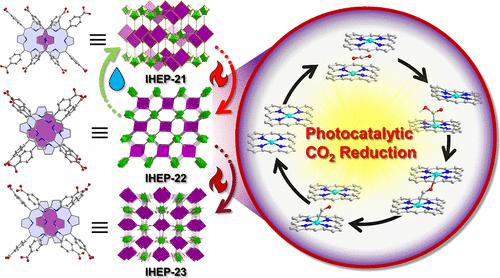当前位置:
X-MOL 学术
›
J. Am. Chem. Soc.
›
论文详情
Our official English website, www.x-mol.net, welcomes your
feedback! (Note: you will need to create a separate account there.)
Thermally Induced Orderly Alignment of Porphyrin Photoactive Motifs in Metal–Organic Frameworks for Boosting Photocatalytic CO2 Reduction
Journal of the American Chemical Society ( IF 14.4 ) Pub Date : 2023-08-02 , DOI: 10.1021/jacs.3c07047
Zhi-Wei Huang 1, 2 , Kong-Qiu Hu 1 , Xiao-Bo Li 1 , Zhi-Ni Bin 1 , Qun-Yan Wu 1 , Zhi-Hui Zhang 3 , Zhi-Jun Guo 2 , Wang-Suo Wu 2 , Zhi-Fang Chai 1 , Lei Mei 1 , Wei-Qun Shi 1
Journal of the American Chemical Society ( IF 14.4 ) Pub Date : 2023-08-02 , DOI: 10.1021/jacs.3c07047
Zhi-Wei Huang 1, 2 , Kong-Qiu Hu 1 , Xiao-Bo Li 1 , Zhi-Ni Bin 1 , Qun-Yan Wu 1 , Zhi-Hui Zhang 3 , Zhi-Jun Guo 2 , Wang-Suo Wu 2 , Zhi-Fang Chai 1 , Lei Mei 1 , Wei-Qun Shi 1
Affiliation

|
Efficient transfer of charge carriers through a fast transport pathway is crucial to excellent photocatalytic reduction performance in solar-driven CO2 reduction, but it is still challenging to effectively modulate the electronic transport pathway between photoactive motifs by feasible chemical means. In this work, we propose a thermally induced strategy to precisely modulate the fast electron transport pathway formed between the photoactive motifs of a porphyrin metal–organic framework using thorium ion with large ionic radius and high coordination number as the coordination-labile metal node. As a result, the stacking pattern of porphyrin molecules in the framework before and after the crystal transformations has changed dramatically, which leads to significant differences in the separation efficiency of photogenerated carriers in MOFs. The rate of photocatalytic reduction of CO2 to CO by IHEP-22(Co) reaches 350.9 μmol·h–1·g–1, which is 3.60 times that of IHEP-21(Co) and 1.46 times that of IHEP-23(Co). Photoelectrochemical characterizations and theoretical calculations suggest that the electron transport channels formed between porphyrin molecules inhibit the recombination of photogenerated carriers, resulting in high performance for photocatalytic CO2 reduction. The interaction mechanism of CO2 with IHEP-22(Co) was clarified by using in-situ electron paramagnetic resonance, in-situ diffuse reflectance infrared Fourier transform spectroscopy, in-situ extended X-ray absorption fine structure spectroscopy, and theoretical calculations. These results provide a new method to regulate the efficient separation and migration of charge carriers in CO2 reduction photocatalysts and will be helpful to guide the design and synthesis of photocatalysts with superior performance for the production of solar fuels.
中文翻译:

金属有机框架中卟啉光活性基序的热诱导有序排列促进光催化二氧化碳还原
通过快速传输路径实现电荷载流子的有效传输对于太阳能驱动的CO 2还原中优异的光催化还原性能至关重要,但通过可行的化学手段有效调节光敏基序之间的电子传输路径仍然具有挑战性。在这项工作中,我们提出了一种热诱导策略,使用具有大离子半径和高配位数的钍离子作为配位不稳定金属节点,精确调节卟啉金属有机框架的光活性基序之间形成的快速电子传输途径。结果,晶体转变前后骨架中卟啉分子的堆积模式发生了巨大变化,导致MOFs中光生载流子的分离效率显着差异。IHEP-22(Co)光催化还原CO 2为CO的速率达到350.9 μmol·h –1 ·g –1,分别是IHEP-21(Co)的3.60倍和IHEP-23(IHEP-23)的1.46倍。有限公司)。光电化学表征和理论计算表明,卟啉分子之间形成的电子传输通道抑制了光生载流子的复合,从而实现了光催化CO 2还原的高性能。利用原位电子顺磁共振、原位漫反射红外傅里叶变换光谱、原位扩展X射线吸收精细结构光谱和理论计算阐明了CO 2 与IHEP-22(Co)的相互作用机理。这些结果为调控CO 2还原光催化剂中载流子的有效分离和迁移提供了一种新方法,有助于指导用于生产太阳能燃料的性能优越的光催化剂的设计和合成。
更新日期:2023-08-02
中文翻译:

金属有机框架中卟啉光活性基序的热诱导有序排列促进光催化二氧化碳还原
通过快速传输路径实现电荷载流子的有效传输对于太阳能驱动的CO 2还原中优异的光催化还原性能至关重要,但通过可行的化学手段有效调节光敏基序之间的电子传输路径仍然具有挑战性。在这项工作中,我们提出了一种热诱导策略,使用具有大离子半径和高配位数的钍离子作为配位不稳定金属节点,精确调节卟啉金属有机框架的光活性基序之间形成的快速电子传输途径。结果,晶体转变前后骨架中卟啉分子的堆积模式发生了巨大变化,导致MOFs中光生载流子的分离效率显着差异。IHEP-22(Co)光催化还原CO 2为CO的速率达到350.9 μmol·h –1 ·g –1,分别是IHEP-21(Co)的3.60倍和IHEP-23(IHEP-23)的1.46倍。有限公司)。光电化学表征和理论计算表明,卟啉分子之间形成的电子传输通道抑制了光生载流子的复合,从而实现了光催化CO 2还原的高性能。利用原位电子顺磁共振、原位漫反射红外傅里叶变换光谱、原位扩展X射线吸收精细结构光谱和理论计算阐明了CO 2 与IHEP-22(Co)的相互作用机理。这些结果为调控CO 2还原光催化剂中载流子的有效分离和迁移提供了一种新方法,有助于指导用于生产太阳能燃料的性能优越的光催化剂的设计和合成。

































 京公网安备 11010802027423号
京公网安备 11010802027423号